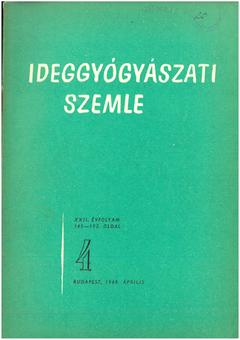The eLitMed.hu medical portal uses computer cookies for convenient operation. Detailed information can be found in the Cookie-policy.
Clinical Neuroscience - 1969;22(04)
Content
[The histological structure of human muscle spindles and innervation ]
[We used a large muscle biopsy from our clinic to investigate how muscle spindles behave in different muscle diseases. However, in many cases, the muscle fragments excised for diagnostic purposes did not contain muscle spindles or only a small number of them. The data in the literature refer mainly to animal muscle spindles (see further as ms). Therefore, the histopathological evaluation of the observed muscle spindle images was difficult. There have been few studies on pathological lesions of human ms. For this reason, we aimed to collect first of all experiences on normal human io. The present study deals with the structure and innervation of normal human io. Our next paper will deal with the development of the ms, and our third paper will discuss the pathophysiological changes of the ms in different neurologically important muscle diseases. ]
[Arrangement of the Rorschach test items]
[In summary, the record paints a picture of a mentally mildly and unevenly retarded, eccentric, self-contained, not very well hidden from others and ambivalently experienced autistic world of a psychopath. The most recognisable is the antisocial psychopath described by Boss (1913), characterised by passivity and lack of self-control, and the data on the quality of his individual world. Circular psychosis, schizophrenia and organic psychosyndrome can already be ruled out by conventional evaluation. In the course of the test, a certain positive development of the personality is to be expected, but there are serious forces working against this, such as the F-unbest. descriptio at the end of the test and the TA response, which emerged in the post-test during the relaxation of censorship, and which indicates a serious generational-familial conflict. In any case, psychotherapy, especially on the basis of further exploration, now gaining new thematic fodder, has an absolute indication, because it allows us to put into practice the gains that a more human, comprehensive and deeper understanding of the patient beyond the label "oligophrenia" or "postprocessual schizoidia" has given us in the extended test evaluation.]
[Data for submicroscopy of panencephalitis. B Intranuclear inclusions, virus-like particles in demyelination and its course]
[In the second stage of processing of biopsy material from the right peristriatai of the right peripheral area of a patient with panencephalitis, the intranuclear inclusions found are more often classified as group II, less often as group I, according to Bouteille's classification, usually resembling a twisted cotton-mat ring with a clear halo around it. Osmiophilic, electrodense-centred, "viral-mimetic" particles are found in large numbers, most often in neurocytes. Their number suggests that the particulate is predominantly transported to the extracellular space from the disintegration of neurocytes. In our study, 27% of the particles are able to reach the CSF space. This puts the extraction of particles from liqur in perspective. The myelin degradation starts from the Ranvier's confinement and follows an axofugal direction. Electrophysiologically, as well as clinicopathologically, the study of panencephalitis is attributed to pathological informative, pathological integrative, and pathological energetic factors. Further studies are ongoing.]
[Neurological complications of multiple myeloma]
[1. Authors describe neurological complications caused by multiple myeloma and plasmocytoma. They were the first symptom of disease in 15% of the total patient population [53] and in 33% of cases with neurological complications. 2. The clinical symptoms, pathogenesis and course of 21 patients with multiple myeloma with neurological complications and 3 patients with plasmocytoma are analysed. 3. X-ray examination, cytological tests (bone marrow smear, bone biopsy) and other laboratory tests (red blood cell count, peripheral blood count, serum and cerebrospinal fluid paper and immunoelectrophoresis) are used to detect early stage disease. Bence-Jones protein was found in urine in only 1/3 of the cases reported here. 4. Un. complex (non-specific robotic, irradiation, cytostatic, in some cases surgical or conservative orthopaedic) treatment of neurological complications was associated with a disease duration of approximately 21.2 months (living patients) and 26.4 months (dead patients) from the time of admission. ]
1.
Clinical Neuroscience
[Headache registry in Szeged: Experiences regarding to migraine patients]2.
Clinical Neuroscience
[The new target population of stroke awareness campaign: Kindergarten students ]3.
Clinical Neuroscience
Is there any difference in mortality rates of atrial fibrillation detected before or after ischemic stroke?4.
Clinical Neuroscience
Factors influencing the level of stigma in Parkinson’s disease in western Turkey5.
Clinical Neuroscience
[The effects of demographic and clinical factors on the severity of poststroke aphasia]1.
2.
Clinical Oncology
[Pancreatic cancer: ESMO Clinical Practice Guideline for diagnosis, treatment and follow-up]3.
Clinical Oncology
[Pharmacovigilance landscape – Lessons from the past and opportunities for future]4.
5.



